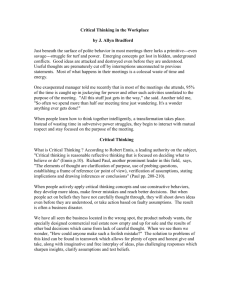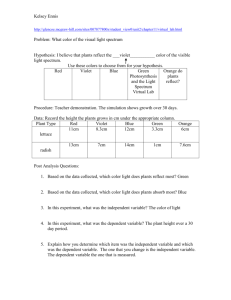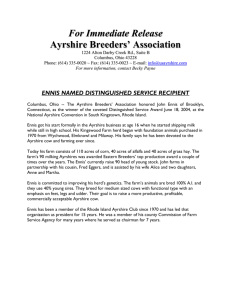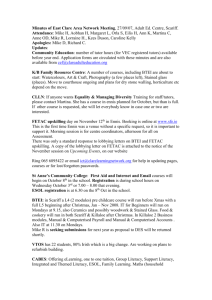Standardized Critical Thinking Assessment Tools 1 College-Level Critical Thinking Exams
advertisement
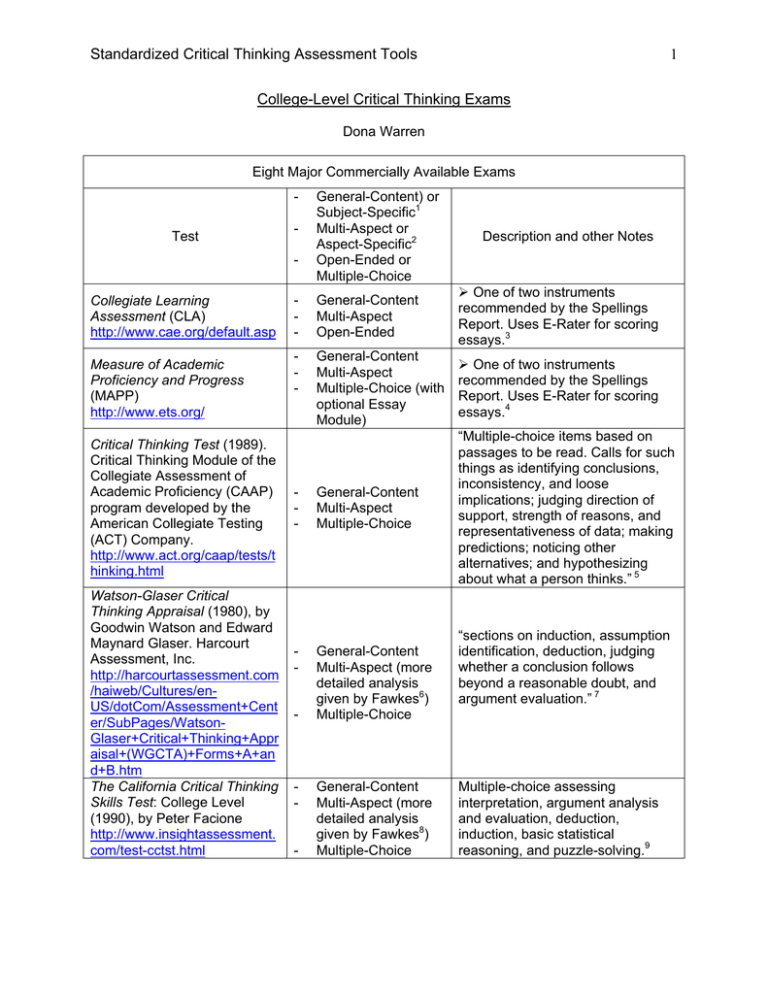
Standardized Critical Thinking Assessment Tools 1 College-Level Critical Thinking Exams Dona Warren Eight Major Commercially Available Exams Test - Collegiate Learning Assessment (CLA) http://www.cae.org/default.asp Measure of Academic Proficiency and Progress (MAPP) http://www.ets.org/ Critical Thinking Test (1989). Critical Thinking Module of the Collegiate Assessment of Academic Proficiency (CAAP) program developed by the American Collegiate Testing (ACT) Company. http://www.act.org/caap/tests/t hinking.html Watson-Glaser Critical Thinking Appraisal (1980), by Goodwin Watson and Edward Maynard Glaser. Harcourt Assessment, Inc. http://harcourtassessment.com /haiweb/Cultures/enUS/dotCom/Assessment+Cent er/SubPages/WatsonGlaser+Critical+Thinking+Appr aisal+(WGCTA)+Forms+A+an d+B.htm The California Critical Thinking Skills Test: College Level (1990), by Peter Facione http://www.insightassessment. com/test-cctst.html General-Content) or Subject-Specific1 Multi-Aspect or Aspect-Specific2 Open-Ended or Multiple-Choice Description and other Notes - General-Content Multi-Aspect Open-Ended ¾ One of two instruments recommended by the Spellings Report. Uses E-Rater for scoring essays.3 - General-Content Multi-Aspect Multiple-Choice (with optional Essay Module) ¾ One of two instruments recommended by the Spellings Report. Uses E-Rater for scoring essays.4 - General-Content Multi-Aspect Multiple-Choice “Multiple-choice items based on passages to be read. Calls for such things as identifying conclusions, inconsistency, and loose implications; judging direction of support, strength of reasons, and representativeness of data; making predictions; noticing other alternatives; and hypothesizing about what a person thinks.” 5 - General-Content Multi-Aspect (more detailed analysis given by Fawkes6) Multiple-Choice - - - General-Content Multi-Aspect (more detailed analysis given by Fawkes8) Multiple-Choice “sections on induction, assumption identification, deduction, judging whether a conclusion follows beyond a reasonable doubt, and argument evaluation.” 7 Multiple-choice assessing interpretation, argument analysis and evaluation, deduction, induction, basic statistical reasoning, and puzzle-solving.9 Standardized Critical Thinking Assessment Tools The Test of Everyday Reasoning (1998) by Peter Facione. California Academic Press. http://www.insightassessment. com/test-ter.html The Cornell Critical Thinking Test, Level X (2005), by Robert H. Ennis and Jason Millman. The Critical Thinking Company. The Cornell Critical Thinking Test, Level Z (2005), by Robert H. Ennis and Jason Millman. The Critical Thinking Company. http://www.criticalthinking.com/ series/055/index_c.html http://www.testingthinking.com /thinking/ns/public/products/cct t-z.jsp 2 - General-Content Multi-Aspect Multiple-Choice “Derived from The California Critical Thinking Skills Test (listed above), with multiple-choice selection of justifications added.” 10 - General-Content Multi-Aspect (more detailed analysis given by Fawkes11) Multiple-Choice “[S]ections on induction, credibility, observation, deduction, and assumption identification.” 12 General-Content Multi-Aspect (more detailed analysis given by Fawkes13) Multiple-Choice “[S]ections on induction, credibility, prediction and experimental planning, fallacies (especially equivocation), deduction, definition, and assumption identification.” 14 - - - Standardized Critical Thinking Assessment Tools 3 Other Exams Test - The California Critical Thinking Disposition Inventory, (1992) by Peter Facione and N. C. Facione.15 http://www.insightassessment. com/test-cctdi.html Assessment of Reasoning and Communication, Reasoning Subtest, (1986). College Outcome Measures Program, The American College Testing Program (ACT) Tasks in Critical Thinking (1993). Educational Testing Service. ICAT Critical Thinking Essay Examination (1996) The International Center for the Assessment of Thinking. http://www.criticalthinking.org/ about/internationalCenter.shtm l James Madison Test of Critical Thinking (2004). The Critical Thinking Company. http://www.criticalthinking.com/ series/057/index_c.html Cornell Class Reasoning Test (1964), by Robert H Ennis, William L. Gardiner, Richard Morrow, Dieter Paulus, and Lucille Ringel. Illinois Critical Thinking Project. http://faculty.ed.uiuc.edu/rhenn is/infocornelldedtests.htm - General-Content) or Subject-Specific Multi-Aspect or Aspect-Specific Open-Ended or Multiple-Choice Description and other Notes - General-Content Multi-Aspect (more detailed analysis given by Fawkes16) Multiple-Choice - General-Content Multi-Aspect Open-Ended - General-Content Multi-Aspect Open-Ended - General-Content Multi-Aspect Open-Ended - General-Content Multi-Aspect Multiple-Choice “Emphasis on elementary deductive logic; also deals with informal fallacies and assumption ascription.” 20 - General-Content Aspect-Specific Multiple-Choice “Available at no cost on Ennis’ academic web site…Tests for a variety of forms of (deductive) class reasoning.” 21 Students produce three short essays and three short speeches, which are graded on pertinence, relevance, plausibility, reasonableness, and realism.17 “A variety of tasks calling for critical thinking. Requires specially trained graders.” 18 “…. Provides eight criteria (to be shown to students in advance and also to be used for grading by trained graders). Students respond to an editorial (selected by test administrator) by writing an essay...” 19 Standardized Critical Thinking Assessment Tools Cornell Conditional Reasoning Test (1964), by Robert H. Ennis, William Gardiner, John Guzzetta, Richard Morrow, Dieter Paulus, and Lucille Ringel. Illinois Critical Thinking Project. http://faculty.ed.uiuc.edu/rhenn is/infocornelldedtests.htm Test on Appraising Observations (1983), by Stephen P. Norris and Ruth King. Department of Educational Policy Studies, University of Alberta. 4 - General-Content Aspect-Specific Multiple-Choice “Available at no cost on Ennis’ academic web site… Tests for a variety of forms of (deductive) conditional reasoning.” 22 - General-Content Aspect-Specific Multiple-Choice and Open-Ended versions “Tests for ability to judge the credibility of statements of observation.” 23 “Asks students to read with comprehension, identify conclusions, interpret data, evaluate experiments, draw probable conclusions from data, and hypothesize best explanations.” 24 “About one half hour for a one-toone interview. People being tested are interviewed about an issue of their choice, and rated on a combination of their displayed subject-matter knowledge and reasoning.”25 “Aimed at grades 4 though college… incorporates the syllogism (heavily represented), assumption identification, induction, good reasons, and kind and degree.” 26 Science Reasoning (1989). ACT CAAP Operations. - Subject-Specific Multi-Aspect Multiple-Choice Critical Thinking Interview (1998), by Gail Hughes and Associates. Minnesota State Colleges and Universities - General-Content Multi-Aspect Open-Ended New Jersey Test of Reasoning Skills (1983), by Virginia Shipman. Institute for the Advancement of Philosophy for Children, Test Division. - General-Content Multi-Aspect Multiple-Choice The Ennis-Weir Critical Thinking Essay Test (1985), by Robert H. Ennis and Eric Weir. Critical Thinking Press and Software. http://faculty.ed.uiuc.edu/rhenn is/Assessment.html - General-Content Multi-Aspect Open-Ended Out of publication but available on Ennis’ web site.27 - General-Content Multi-Aspect Multiple-Choice and Essay “Two parts: a half-hour, 15-item, multiple-choice test of argument assessment; and a one-hour essay test calling for critical evaluation of an argument and for further argumentation.” 28 Critical Thinking (1996). Local Examinations Syndicate, University of Cambridge. Standardized Critical Thinking Assessment Tools 5 References Ennis, Robert H., “An Annotated List of Critical Thinking Tests,” Revised June, 2006 http://www.criticalthinking.net/TestList.html. Ennis, Robert H., “Nationwide Testing of Critical Thinking for Higher Education: Vigilance Required,” revised version of a paper presented at a session sponsored by the Association for Informal Logic and Critical Thinking and the American Philosophical Association Committee on the Teaching of Philosophy on Thursday, 19 April 2007 at the APA Central Division meeting, 2007. http://ailact.mcmaster.ca/papers.htm. Fawkes, Don, “Analyzing the Scope of Critical Thinking Exams,” APA Newsletter on Teaching in Philosophy, Spring 2001, Volume 00, Number 2. http://www.apa.udel.edu/apa/publications/newsletters/v00n2/teaching/02.asp Fawkes, Don, Tom Adajian, Dan Flage, Steven Hoeltzel, Bill Knorpp, Mill O’Meara, Dave Weber, “Examining the Exam: A Critical Look at the Watson-Glaser Critical Thinking Appraisal Exam,” Inquiry: Critical Thinking Across the Disciplines, Summer 2001, Vol. 20, No. 4, pp. 19-33. U. S. Department of Education, A test of leadership: Charting the future of U. S. higher education (A report of the Commission appointed by Secretary of Education Margaret Spellings). Washington, D. C.: U. S. Government Printing Office, 2006. http://www.ed.gov/about/bdscomm/list/hiedfuture/index.html 1 Distinction from Ennis, “Annotated List” Distinction from Ennis, “Annotated List” 3 Ennis, “Nationwide Testing of Critical Thinking for Higher Education: Vigilance Required,” p. 4 4 Ennis, “Nationwide Testing of Critical Thinking for Higher Education: Vigilance Required,” p. 4 5 Ennis, “Annotated List” 6 Fawkes, “Analyzing the Scope” 7 Ennis, “Annotated List” 8 Fawkes, “Analyzing the Scope” 9 Ennis, “Annotated List” 10 Ennis, “Annotated List” 11 Fawkes, “Analyzing the Scope” 12 Ennis, “Annotated List” 13 Fawkes, “Analyzing the Scope” 14 Ennis, “Annotated List” 15 Ennis, “Annotated List” 16 Fawkes, “Analyzing the Scope” 17 Ennis, “Annotated List” 18 Ennis, “Annotated List” 19 Ennis, “Annotated List” 20 Ennis, “Annotated List” 21 Ennis, “Annotated List” 22 Ennis, “Annotated List” 23 Ennis, “Annotated List” 24 Ennis, “Annotated List” 25 Ennis, “Annotated List” 26 Ennis, “Annotated List” 27 Ennis, “Annotated List” 28 Ennis, “Annotated List” 2

